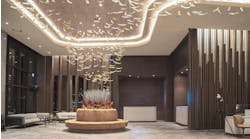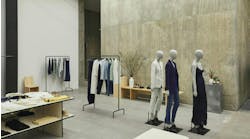How has the healthcare industry responded to the need to improve patient satisfaction and promote healing? By redesigning their facilities to make them feel more like a grand hotel than an institution, by adding art, and by expanding daylighting, bringing nature indoors with plants and water features, and opening views to the outdoors. When companies wanted to drive creativity and innovation, what did they do? They called on designers to reinvent the workplace to encourage more collaboration and group interaction, turn dreary lunchrooms into buzzing coffee bars, and introduce areas for play and socialization.
These are just a couple of examples—there are many many more—of how interior designers every day are transforming lives by providing solutions to help their clients and society at large address some of today’s most pressing challenges. How has this come about? For one thing, clients are more aware that they need to focus on people, not just systems and technology. For example, according to a study from Terrapin Bright Green, 90 percent of a company’s operating costs are linked to human resources. And who knows more about how the physical environment affects people than interior designers?
Second, with the growth of evidence-based design, we now have a substantial body of research and case studies that we can draw upon to demonstrate to clients and other decision-makers the impact of design on behavior, wellness, and well-being. We know, for example, that many health and wellness issues are linked to the workplace. A study conducted last year by Dodge Data, “The Drive Toward Healthier Buildings,” to which ASID contributed, established how poor and unhealthy building design contributes to employee illness and injury, as well as depression and stress, which lead to decreased productivity, error, and poor performance. Drawing on recent research, the report also points out how design can help mitigate absences and ailments by employing such proven methods and practices as incorporating natural ventilation, access to daylighting and lighting to mimic circadian rhythms, access to outside views, proper lighting, low-VOC products, and ergonomic design, among others.
As this example shows, health and wellness are just one area where designers can achieve positive impacts and transform lives. Today’s complex built environments require holistic solutions that balance mechanical requirements of building performance with the essential human needs of occupants and the business or lifestyle needs
of our clients. Our designs have the greatest impact when they incorporate and integrate sustainability and resilience along with health and wellness. Because these are the areas of the built environment that we deal with every day, this is where we can make our greatest contribution.
At ASID, we believe interior designers will increasingly be called upon to design spaces that encourage positive behaviors and enhance the human condition, not just in the workplace and healthcare, but also in education, retail, hospitality, and housing. Initiatives like the WELL Building Standard are a harbinger of where the industry is headed. We are focusing our efforts on preparing designers to assume a leadership role in this transformation.
In August of last year, ASID announced a commitment to the Clinton Global Initiative to develop ASID Protocols for Health and Wellness in Design to improve human well-being through better design and construction. That commitment helped lead to the development of a new education and technology platform, the ASID Academy, to help designers make smarter design decisions about products, materials, and building components that place occupant health and wellness first.
Another goal of the CGI commitment is to bring the various disciplines within the built environment together to meet and collaborate with a variety of stakeholders. This provides us with new opportunities to interact with decision-makers who would not regularly interact with designers and educate them about what we do. By working together toward a common goal, they can see firsthand the value and impact of design.
I recently attended the first Impact Summit, hosted by ASID and the Interior Designers of Canada (IDC), held at the Lake Nona Medical City in Orlando, Fla. Over two days, designers, thought leaders, and representatives from the government, non-profit, and private sectors met to learn about recent developments in design and to collaborate on creating strategies that will result in healthier people and buildings. Because it is a community comprised of medical, educational, commercial, retail, and residential buildings, it was an ideal location to show firsthand how all design niches have an impact on the human experience.
Although it often is not top-of-mind for them, when clients and decision-makers experience for themselves the impact of design on wellness, well-being, and quality
of life, they want it for themselves. It is up to us to raise their awareness. Before your next presentation, think about how you will demonstrate the value of the impact of design to your client.
Sandy Gordon, MFA, FASID, LEED AP, is chair of the ASID Board of Directors, and principal of Sandy Gordon Interiors, a consultant firm based in Madison, Wis. Learn more about ASID at ASID.org.


